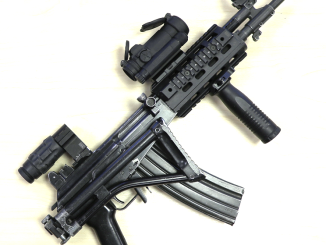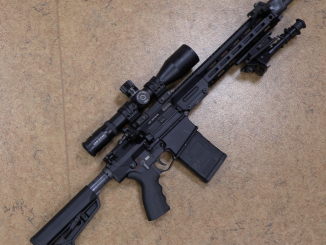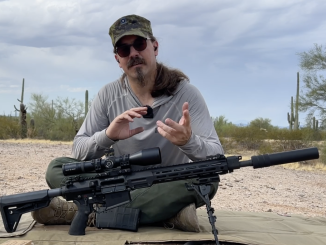At the end of Estonia’s war of independence in 1920, the new nation’s government began working on military infrastructure. One thing it would need was a repair depot to maintain military equipment, everything from barracks furniture to arms and vehicles. A large building was obtained in Tallinn (the capital city) and a number of small shop moved to the new premises to work together. Over the 1920s, this central repair depot grew in size and capability, and in 1924 is was officially named Arsenal Tallinn. It is probably best known for the design and construction of a series of Estonian armored cars, but in 1926 it took up a project to design and build a submachine gun. Building on experience making replacement parts for other weapons, Johannes Teiman (head of the Arsenal technical department) put together a design based largely on the German MP18.I.
The Tallinn SMG – which never had any more specific designation that I have been able to find – was simple blowback, used a progressive trigger fir semi and full auto firing, and was chambered for the 9x20mm Browning semi-rimmed cartridge. It fed from 50-round magazines that mounted at a slight backward angle to prevent rimlock. the design underwent a successful endurance test in November 1926, and slow mass production began. In total, about 630 appear to have been made (but that number is uncertain due to the 1940 destruction of Arsenal records). Most (437) went to the Estonian Defense League, with the remainder split between the Army and police.
The 9x20SR chambering was chosen because at that time, the official service sidearm of the Estonian Defense Forces was the FN 1903 pistol, chambered for the same 9x20SR. In the 1930s these were replaced by FN High Powers in 9mm, and Arsenal developed a modification to convert the SMGs to 9×19. This modification was ready in 1938, but never put into production. Instead, the existing SMGs were sold (a few to Latvia but most to Spain) and the money used to purchase brand new Suomi KP31 submachine guns from Finland. It appears that 485 Suomi’s made it to Estonia before the Winter War. The Tallinn guns sent to Spain had a very low survival rate, and complete examples are extremely rare today.
Many thanks to the Estonian War Museum for allowing me to take this one out of their display to film for you. If you find yourself in Tallinn, definitely take time to stop by and check them out! Hours and rotating exhibits are available on their web site: https://esm.ee
Estonian Mosin Conversion: https://youtu.be/XK82Tw3lwgo
Estonian High Power: https://youtu.be/foWZnq42DA0




“(…)fed from 50-round magazines(…)”
https://modernfirearms.net/en/submachine-guns/estonia-submachine-guns/tallinn-arsenal-eng/ claims that
Magazine capacity 40 rounds
so which is real capacity?
Personally I think most of the details would suggest that this weapon was actually based on the SIG Bergmann M.P., which in turn was a copy of the Bergmann M.P.18,III, not the Bergmann M.P.18,I.
Nikita Ovodkov also gives 40 as the capacity in Иностранные пистолеты-пулемёты в собрании Исторического музея Артиллерии, инженерных войск и войск связи (‘Foreign Submachine Guns in the Collection of the Military-Historical Museum of Artillery, Engineer and Signal Corps’). There are three specimens in that collection, apparently, which would suggest that 40 is correct.
Yes, this is correct, the Tallinn Arsenal submachine gun is based on the SIG Bergmann which had been sold to Finland and Estonia in the early 1920s.
Which leads to question why they elected to lessen magazine capacity, considering that for http://modernfirearms.net/en/submachine-guns/switzerland-submachine-guns/sig-1920-1930-eng/ it was 50?
Difficult to say without actually examining it (the alleged 40-rounders), but those 50-rounders are very long and unwieldy.
Some of these guns – in perfect shooting condition – are surely still there (Härra, I am not watering flowers with oil, I am just conserving some stuff under my doorstep).
Pretty sure that there are a lot of those sorts of things in deep storage/concealment all across Europe.
God knows I’d have been out harvesting the left-overs after all the battles rolled over, and keeping them maintained “just in case” the idiots ever came back. I met a Latvian guy whose family had a bunch of relatives who were “Forest Brothers”, and from what he said, the peacetime diversions from Soviet stocks during the late 1960s were legion. The way he told it, the Soviet logistics system was permeated with career warrant officers from the Baltic states, and they took every opportunity to rob the Soviet system blind. Even if they didn’t need it, they stole it opportunistically… He had stories of entire railway cars out in the woods surrounding depots that had been “vanished” off the books by these characters.
No idea about the truth of the stories he told, but they do “sound right” to my ear. I mean, good God, the Soviet troops in Afghanistan were trading ammo to the Afghan insurgents for drugs and food…
The problem maybe is the ammo, how long does it last ?
40,50,60 years ?
…many many years ago, my friend, who – as a student – was running a tourist hiking association mountain shelter in Carpathians, ended up his post-university military service and went back to the mountains, to visit the old place. He had a gift for a local poacher (and an ex-partisan) whom he had befriended. When he spilled on a table a pile of ammo of all possible Warsaw Pact calibres/ sizes, he managed to pilfer during his service, the Poacher looked intently, just for a while.
My friend: “will any of these be good?”
The Poacher: “Andrew, all of them will fit”.
“(…)magazines that mounted at a slight backward angle(…)”
Was said angle same or different that in Kpist m/37 https://smallarmsreview.com/swedish-quality-the-kpist-m-37-and-m-37-39-submachine-guns/ if second why?